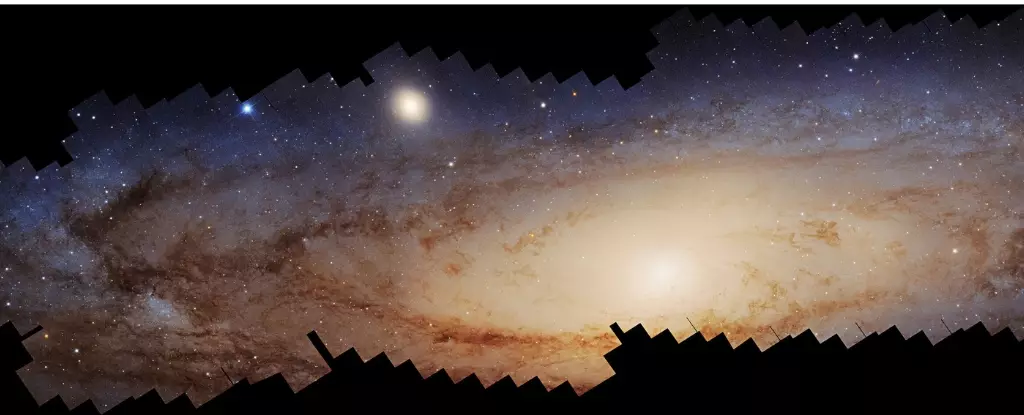With its ethereal glow and enigmatic presence, the Andromeda Galaxy remains a pinnacle of cosmic intrigue. As Earth’s nearest spiral galaxy, spanning approximately 2.5 million light-years away, Andromeda (also known as M31) serves not only as a celestial counterpart to our Milky Way but also as an invaluable resource for astronomers seeking to unravel the secrets of galactic evolution. Visibly discernible to the naked eye under optimal conditions, Andromeda appears as a soft, silvery smudge in the night sky, offering a glimpse into the vastness of the universe.
Among the many instruments that have probed the depths of space, the Hubble Space Telescope stands out for its monumental achievements in celestial observation. Over the span of a decade, Hubble orchestrated an extraordinary endeavor that resulted in a stunning 2.5-gigapixel mosaic of Andromeda, revealing intricate details across the galaxy’s complete expanse. With over 1,000 orbits around Earth, this meticulous imaging process helped capture an astounding 200 million stars brighter than our sun. Despite focusing on such luminous stars, the mosaic only scratches the surface, as many dimmer stars, such as red dwarfs, remain undetected.
This remarkable imaging initiative involved two main observing programs: the Panchromatic Hubble Andromeda Treasury (PHAT) and its southern counterpart, the Panchromatic Hubble Andromeda Southern Treasury (PHAST). Together, these programs not only enhanced imagery and data collection but also enriched our understanding of stellar populations in Andromeda and its galactic structure.
Understanding the complexity of our native galaxy poses numerous challenges, from line-of-sight hindrances to uncertain distance metrics. However, M31 offers a unique vantage point for researchers. By analyzing Andromeda—a galaxy structurally akin to the Milky Way—astronomers can glean insights into our own galactic intricacies. “M31 studies circumvent complications from line-of-sight reddening, uncertain distances, and background/foreground confusion,” state the authors of a recent study published in the Astrophysical Journal. This ability to analyze a nearby spiral galaxy helps us contextualize our understanding of stars, the interstellar medium, and the overall star formation rate, providing a clearer image of galactic life.
Furthermore, Andromeda is an essential galactic proxy, enabling scientists to assess its properties through the lens of its surrounding environment and structural composition. Its unique qualities allow researchers to make comparisons to the detailed knowledge we currently possess about the Milky Way, leading to further advancements in our understanding of galaxy formation and evolution.
The study of Andromeda has unveiled layers of complexity about its merger history. Notably, researchers have identified significant disparities between the northern and southern disks of the galaxy. The southern disk appears more disturbed and tumultuous—an echo of the dynamic interactions Andromeda has experienced throughout its existence. This revelation signifies how mergers with smaller galaxies can impact stellar formation and distribution over billions of years.
The presence of M32, an early-type dwarf galaxy, suggests that it could represent remnants of a more massive galaxy that merged with Andromeda several billion years ago. The legacy of these galactic interactions is further supported by evidence such as the Giant Southern Stream—a tidal debris stream indicating ancient collisions that profoundly shaped Andromeda. Understanding this history is vital; the metallicity variations observed in the stars across the galaxy provide clues to the complex processes involved in its formation.
With the continuous advancement of astronomical technology, the study of Andromeda is on the cusp of a new era. The anticipated launch of the Nancy Grace Roman Space Telescope aims to enhance our understanding significantly. With its capabilities extending to capturing a wide field of view, this infrared telescope can produce the equivalent of 100 high-resolution images in a single exposure. This revolutionary tool could provide unprecedented insights into the Giant Southern Stream and other integral features of M31, continuing the rich legacy of Andromeda exploration.
The Andromeda Galaxy beckons us from the dark stretches of space, reminding us of the endless mysteries surrounding our cosmic existence. Through initiatives spearheaded by telescopes like Hubble and the forthcoming Roman Space Telescope, we open doors to better understand not just Andromeda, but our own Milky Way as well. As we peer into the fabric of the universe, Andromeda stands as a testament to the beauty, complexity, and interconnectedness of cosmic phenomena, inviting both curiosity and deeper exploration of the cosmos.


Leave a Reply